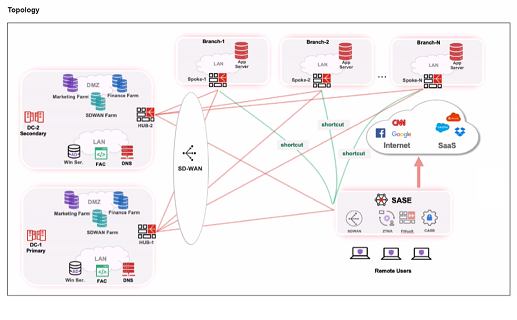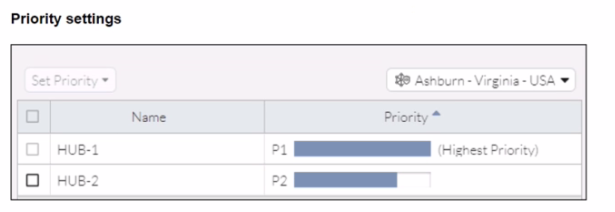Curious about Actual Fortinet Certified Solution Specialist (FCSS_SASE_AD-23) Exam Questions?
Here are sample Fortinet FCSS - FortiSASE 23 Administrator (FCSS_SASE_AD-23) Exam questions from real exam. You can get more Fortinet Certified Solution Specialist (FCSS_SASE_AD-23) Exam premium practice questions at TestInsights.
Refer to the exhibits.


When remote users connected to FortiSASE require access to internal resources on Branch-2. how will traffic be routed?
Correct : C
When remote users connected to FortiSASE require access to internal resources on Branch-2, the following process occurs:
SD-WAN Capability:
FortiSASE leverages SD-WAN to optimize traffic routing based on performance metrics and priorities.
In the priority settings, HUB-1 is configured with the highest priority (P1), whereas HUB-2 has a lower priority (P2).
Traffic Routing Decision:
FortiSASE evaluates the available hubs (HUB-1 and HUB-2) and selects HUB-1 due to its highest priority setting.
Once the traffic reaches HUB-1, it is then routed to the appropriate branch based on internal routing policies.
Branch-2 Access:
Since HUB-1 has the highest priority, FortiSASE directs the traffic to HUB-1.
HUB-1 then routes the traffic to Branch-2, providing the remote users access to the internal resources.
FortiOS 7.2 Administration Guide: Details on SD-WAN configurations and priority settings.
FortiSASE 23.2 Documentation: Explains how FortiSASE integrates with SD-WAN to route traffic based on defined priorities and performance metrics.
Start a Discussions
Which two additional components does FortiSASE use for application control to act as an inline-CASB? (Choose two.)
Correct : B, D
FortiSASE uses the following components for application control to act as an inline-CASB (Cloud Access Security Broker):
SSL Deep Inspection:
SSL deep inspection is essential for decrypting and inspecting HTTPS traffic to identify and control applications and data transfers within encrypted traffic.
This allows FortiSASE to enforce security policies on SSL/TLS encrypted traffic, providing visibility and control over cloud applications.
Web Filter with Inline-CASB:
The web filter component integrates with inline-CASB to monitor and control access to cloud applications based on predefined security policies.
This combination provides granular control over cloud application usage, ensuring compliance with security policies and preventing unauthorized data transfers.
FortiOS 7.2 Administration Guide: Details on SSL deep inspection and web filtering configurations.
FortiSASE 23.2 Documentation: Explains how FortiSASE acts as an inline-CASB using SSL deep inspection and web filtering.
Start a Discussions
Which two advantages does FortiSASE bring to businesses with multiple branch offices? (Choose two.)
Correct : A, D
FortiSASE brings the following advantages to businesses with multiple branch offices:
Centralized Management for Simplified Administration:
FortiSASE provides a centralized management platform that allows administrators to manage security policies, configurations, and monitoring from a single interface.
This simplifies the administration and reduces the complexity of managing multiple branch offices.
Eliminates the Need for On-Premises Firewalls:
FortiSASE enables secure access to the internet and cloud applications without requiring dedicated on-premises firewalls at each branch office.
This reduces hardware costs and simplifies network architecture, as security functions are handled by the cloud-based FortiSASE solution.
FortiOS 7.2 Administration Guide: Provides information on the benefits of centralized management and cloud-based security solutions.
FortiSASE 23.2 Documentation: Explains the advantages of using FortiSASE for businesses with multiple branch offices, including reduced need for on-premises firewalls.
Start a Discussions
When accessing the FortiSASE portal for the first time, an administrator must select data center locations for which three FortiSASE components? (Choose three.)
Correct : A, B, D
When accessing the FortiSASE portal for the first time, an administrator must select data center locations for the following FortiSASE components:
Endpoint Management:
The data center location for endpoint management ensures that endpoint data and policies are managed and stored within the chosen geographical region.
Points of Presence (PoPs):
Points of Presence (PoPs) are the locations where FortiSASE services are delivered to users. Selecting PoP locations ensures optimal performance and connectivity for users based on their geographical distribution.
Logging:
The data center location for logging determines where log data is stored and managed. This is crucial for compliance and regulatory requirements, as well as for efficient log analysis and reporting.
FortiOS 7.2 Administration Guide: Details on initial setup and configuration steps for FortiSASE.
FortiSASE 23.2 Documentation: Explains the importance of selecting data center locations for various FortiSASE components.
Start a Discussions
During FortiSASE provisioning, how many security points of presence (POPs) need to be configured by the FortiSASE administrator?
Correct : D
During FortiSASE provisioning, the FortiSASE administrator needs to configure at least one security point of presence (PoP). A single PoP is sufficient to get started with FortiSASE, providing the necessary security services and connectivity for users.
Security Point of Presence (PoP):
A PoP is a strategically located data center that provides security services such as secure web gateway, firewall, and VPN termination.
Configuring at least one PoP ensures that users can connect to FortiSASE and benefit from its security features.
Scalability:
While only one PoP is required to start, additional PoPs can be added as needed to enhance redundancy, load balancing, and performance.
FortiOS 7.2 Administration Guide: Provides details on the provisioning process for FortiSASE.
FortiSASE 23.2 Documentation: Explains the configuration and role of security PoPs in the FortiSASE architecture.
Start a Discussions
Total 30 questions